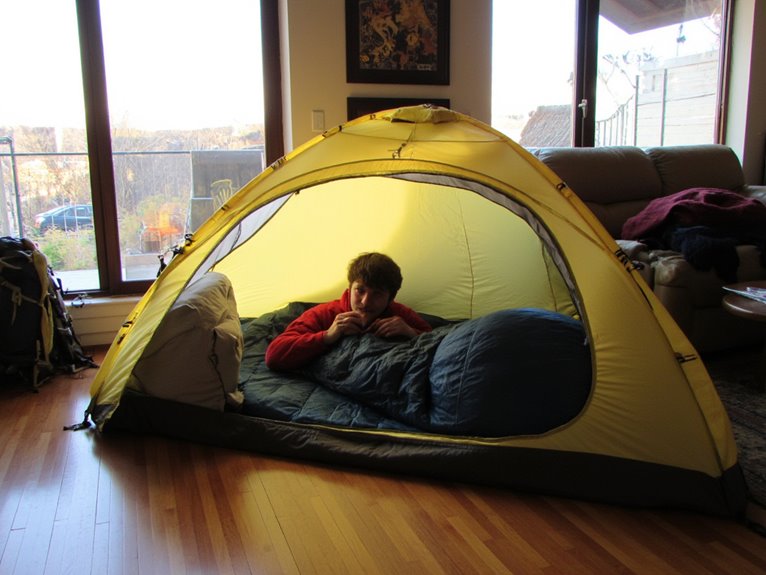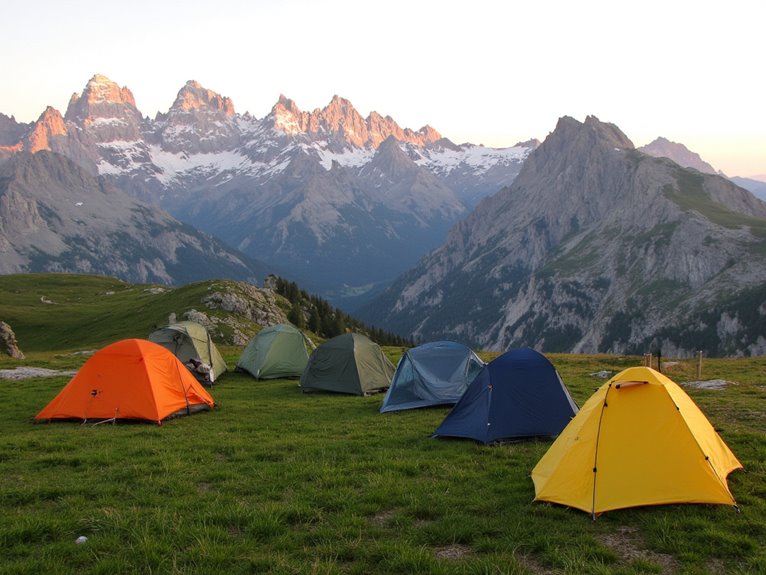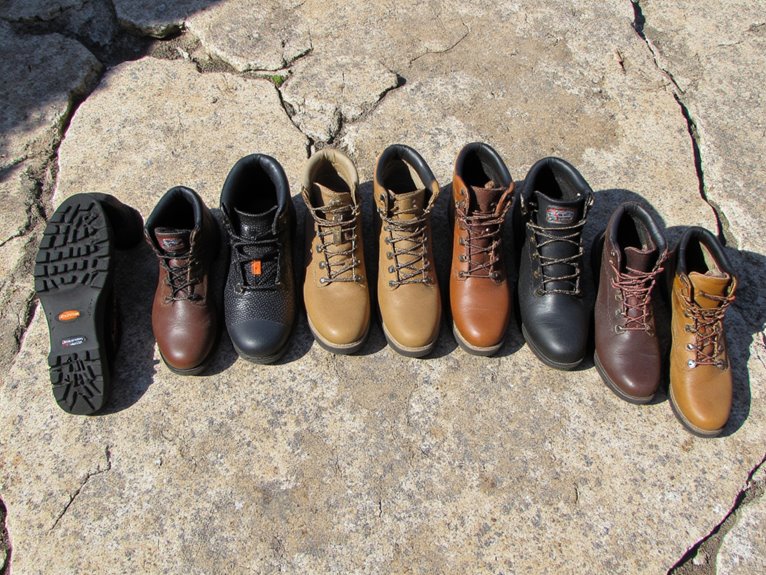How to Test Your Sleep System Before a Big Trip (At Home or in the Field)
Test your sleep system by assembling your complete setup at home for two consecutive nights, checking for pressure points and temperature regulation issues. Verify your sleeping pad’s R-value matches your bag’s rating and test inflation times. Shift your sleep schedule 30-60 minutes toward your destination’s timezone three days before departure, using melatonin if needed. Conduct field trials in simulated conditions with identical clothing layers and equipment configurations. The following thorough approach guarantees ideal rest during your expedition.
We are supported by our audience. When you purchase through links on our site, we may earn an affiliate commission, at no extra cost for you. Learn more. Last update on 10th December 2025 / Images from Amazon Product Advertising API.
Notable Insights
- Assemble your complete sleep system at home and spend two nights testing for pressure points and temperature regulation issues.
- Verify sleeping pad R-value matches your bag’s temperature rating and test inflatable pad inflation times and valve functionality.
- Simulate destination conditions in field trials using identical clothing layers and equipment configurations you’ll use while traveling.
- Document temperature readings, comfort levels, and equipment failures during realistic environmental exposure including wind and ground irregularities.
- Test essential medical equipment like CPAP machines with backup power sources and verify device accuracy in various positions.
Setting Up and Testing Your Complete Sleep System at Home
Before you venture into the wilderness, testing your complete sleep system at home eliminates costly mistakes and uncomfortable nights in the field. Start by assembling your sleeping bag, pad, pillow, and liner in your living space. This setup simulation allows thorough component compatibility assessment without environmental variables.
Focus on comfort evaluation during extended testing periods. Spend two full nights using your system to identify pressure points, temperature regulation issues, and space constraints. Check that your sleeping pad’s R-value matches your bag’s temperature rating. Test inflatable pad inflation times and valve functionality.
Spend two nights testing your sleep system at home to identify pressure points, temperature issues, and equipment compatibility problems.
Simulate outdoor conditions using fans or temperature adjustments. Verify that components pack efficiently into your backpack. Document any compatibility issues between bag dimensions and pad width.
Practice assembly sequences to guarantee field efficiency and identify potential equipment failures before departure. Clear your test area of sharp objects and debris to prevent damage to the pad, mirroring proper ground preparation techniques you’ll use outdoors.
Preparing Your Sleep Schedule and Hygiene Routine
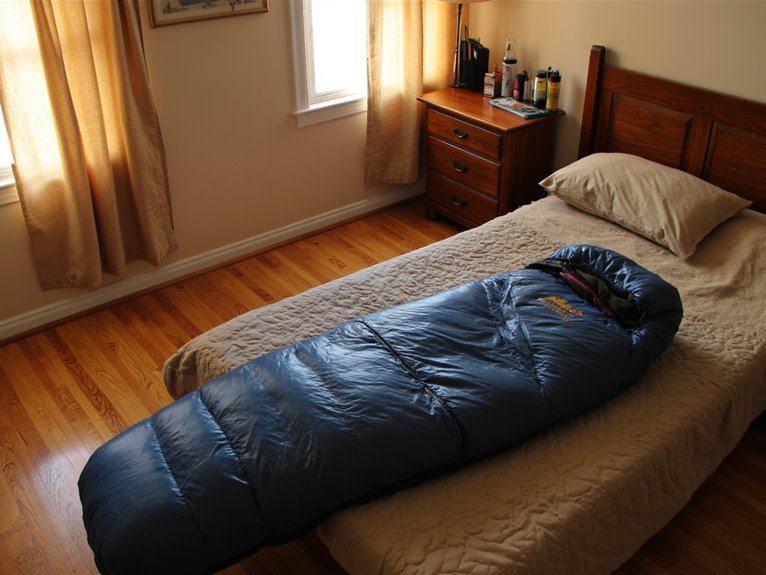
Once you’ve verified your gear performs as expected, optimizing your body’s internal clock becomes equally critical for wilderness sleep success. Your sleep schedule requires systematic adjustment starting three days before departure.
Begin shifting bedtime 30-60 minutes earlier daily when traveling east, or later when heading west.
Essential preparation strategies include:
- Light exposure manipulation: Use bright morning light (10,000 lux) for eastward travel, evening light for westward destinations
- Melatonin timing: Take 0.5mg doses 30 minutes before desired bedtime in your destination timezone
- Consistent routines: Maintain identical pre-sleep activities regardless of location changes
Your hygiene routine becomes your anchor during travel disruption.
Establish non-negotiable practices: technology shutdown 60 minutes before sleep, controlled hydration timing, and specific relaxation protocols.
These consistent behavioral cues signal sleep onset regardless of environmental changes.
Testing Essential Medical Equipment for Sleep-Related Needs
CPAP machines demand overnight trials with backup power sources and portable batteries rated for 8-10 hours continuous operation. Test your pulse oximeter’s accuracy by comparing readings with clinical-grade devices during various sleep positions.
Smart wearables tracking heart rate require calibration against chest strap monitors to verify precision within ±3 BPM during REM cycles.
For sleep apnea patients, verify your device’s pressure settings match prescribed parameters through home sleep studies. Document oxygen saturation levels, apnea-hypopnea index readings, and leak rates over three consecutive nights.
Portable sleep monitors need weatherproofing validation and data transmission testing in simulated field conditions. Always coordinate equipment modifications with your sleep specialist before departure.
Conducting Overnight Trials in Realistic Field Conditions

Laboratory testing can’t replicate the harsh realities of wilderness sleep conditions, making field trials your most critical validation step.
You’ll need to simulate your destination’s specific environment to identify gear limitations before they compromise your trip.
Set up your complete system exactly as planned for the expedition. Use identical clothing layers, sleeping positions, and equipment configurations. This reveals performance gaps that controlled indoor testing misses.
For effective field conditions testing:
- Match environmental factors – Test in similar temperatures, humidity, and terrain as your destination
- Include realistic disturbances – Account for wind noise, ground irregularities, and wildlife activity
- Limit artificial comforts – Avoid extra heat sources or conveniences unavailable during your actual trip
Document temperature readings, comfort levels, and equipment failures. Multiple overnight trials provide reliable performance data for system refinements.
Pay special attention to your sleeping pad’s R-value performance during cold-weather trials, as inadequate insulation becomes critically apparent when ground temperatures drop below your gear’s rated capabilities.
Building a Comprehensive Sleep System Packing List
A methodical approach to packing list development guarantees you’ll carry every essential component without redundant gear weighing down your pack.
Your sleep system essentials begin with a three-season sleeping bag rated to 20°F and a quality sleeping pad like the Sea to Summit XT Insulated Pad, weighing just over one pound.
A quality three-season sleeping bag and lightweight insulated pad form the foundation of any effective backcountry sleep system.
Add a travel pillow such as the Cabeau Air TNE for neck support.
Effective packing techniques prioritize ultralight systems under three pounds total weight. Down sleeping bags offer superior weight-to-warmth ratios at approximately $400 for quality models.
Include accessories like the Manta Sleep Eye Mask and Loop Quiet Earplugs for light and noise control.
Pack a waterproof shell to protect down insulation from moisture. Consider adding a compact sound machine and hydration system for enhanced sleep quality during extended trips.
For maximum portability, invest in a sleeping bag with a compression sack that can reduce packed size by up to 40% to water bottle dimensions.
Monitoring and Fine-Tuning Your Sleep Setup During Travel
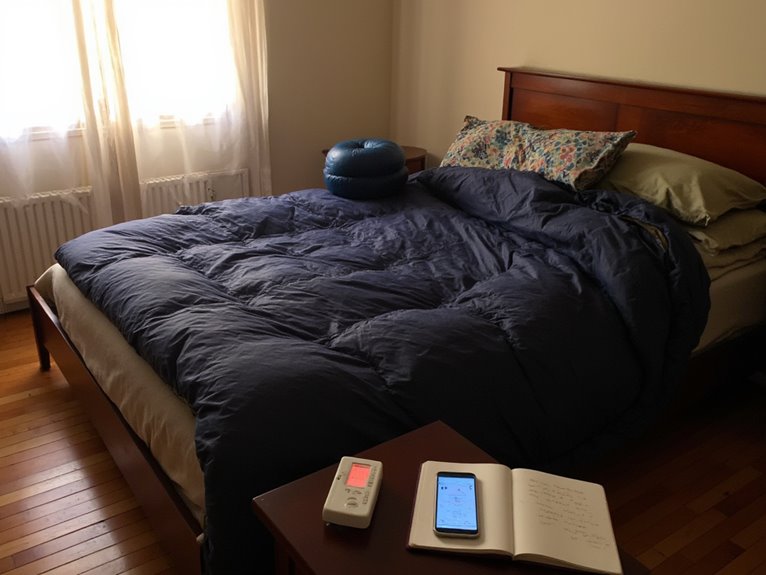
Once you’re in the field, your sleep system requires continuous monitoring to maintain peak performance across changing environments.
You’ll need to conduct daily assessments of sleep quality metrics—including duration, efficiency, and disturbance frequency—while simultaneously adjusting gear configurations based on environmental factors like temperature fluctuations, noise levels, and humidity changes.
Pay particular attention to your sleeping pad’s thermal performance in cold conditions, as R-values become critical when temperatures drop below 40°F and inadequate insulation can compromise your entire sleep system.
This dual approach of systematic data collection and responsive equipment modification guarantees your sleep setup adapts to real-world conditions rather than failing when you need it most.
Daily Sleep Quality Assessment
How effectively is your sleep system performing night after night during your travels? Daily sleep quality assessment provides critical data for optimizing your setup in real-time.
Consistent monitoring reveals patterns that single-night evaluations miss entirely.
Implement these essential assessment tools during your travels:
- Sleep Quality Scale (SQS): Rate your sleep satisfaction across six domains each morning using a standardized 1-10 scale
- Activity logs: Document environmental factors like temperature, noise levels, and setup modifications that impact performance
- Reaction time tests: Use smartphone apps to measure alertness levels, indicating sleep effectiveness objectively
Environmental variables change constantly during travel. Temperature fluctuations, altitude shifts, and varying noise levels all affect your system’s performance.
Document these variables alongside your subjective assessments. This data reveals which conditions compromise your setup and guides necessary adjustments.
Adaptive Gear Adjustments
While daily assessment provides the foundation for understanding your sleep system’s performance, real-time adjustments during travel determine whether you’ll wake up refreshed or exhausted.
Your gear variation strategy must include modular components that adapt quickly to changing conditions. Monitor body signals like shivering or sweating as cues for immediate adjustments.
Climate adaptability requires strategic layering protocols. Add sleeping bag liners when temperatures drop unexpectedly, or open ventilation systems when warmth increases.
Keep essential adjustment tools accessible: quick-release straps, modular insulation layers, and repair kits within arm’s reach.
Practice rapid modifications before your trip. Establish procedures for adding bed liners, adjusting pad R-values, or deploying wind barriers.
Document successful adjustment combinations for different temperature ranges, creating a reference system for future expeditions.

